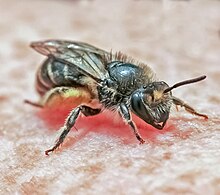Colletidae
| Colletidae | |
|---|---|

| |
| Colletes daviesanus | |
| Scientific classification | |
| Domain: | Eukaryota |
| Kingdom: | Animalia |
| Phylum: | Arthropoda |
| Class: | Insecta |
| Order: | Hymenoptera |
| Clade: | Anthophila |
| Family: | Colletidae Lepeletier, 1841 |
| Subfamilies | |
The Colletidae are a
genera, and over 2000 species are all (with the known exception of but one species, Amphylaeus morosus)[2] evidently solitary, though many nest in aggregations. Two of the subfamilies, Euryglossinae and Hylaeinae, lack the external pollen-carrying apparatus (the scopa
) that otherwise characterizes most bees, and instead carry the pollen in their crops. These groups, and most genera in this family, have liquid or semiliquid pollen masses on which the larvae develop.
They can be found all over the world, but the most species live in South America and Australia. Over 50% of all bee species living in Australia belong to this family.Hylaeus can be found in Europe, while in the Western Hemisphere, in addition to these two, the genera Caupolicana, Eulonchopria, and Ptiloglossa are found.
Australian genera include Euhesma, a large genus, members of which has been split off into other genera such as Euryglossa and Callohesma.[4]

Traditionally, this family is believed to be likely the most "primitive" among extant bees, based primarily on the similarities of their mouthparts (the unique possession among bees of a bilobed
sensu lato) as the basal group of bees.[5]
"Nocturnal" species
The Colletidae are one of the four bee families that contain some
.Systematics
- Subfamily Colletinae — worldwide
- Tribe Paracolletini
- Tribe Colletini
- Tribe Scraptrini
- Subfamily Diphaglossinae — Americas
- Subfamily Xeromelissinae — tropical Americas

- Subfamily Hylaeinae — yellow-faced bees,[6] worldwide
- Subfamily Euryglossinae — Australian
References
- C. D. Michener(2007) The Bees of the World, 2nd Edition, pg. 133, Johns Hopkins University Press.
- ^ "Strange bee-haviour: Social life of Australian species offers insights on evolution, scientists say". www.theguardian.com. 15 June 2022. Retrieved 15 June 2022.
- ISSN 1297-9678.
- ISBN 978-0-8018-6133-8. Retrieved 8 December 2010.
- PMID 17015826.
- ^ "Encyclopedia of Life entry for Hylaeinae". Retrieved 3 December 2014.
